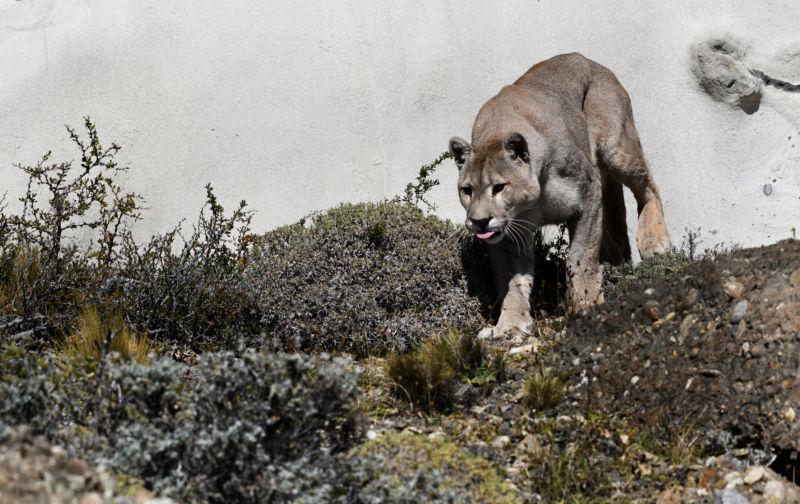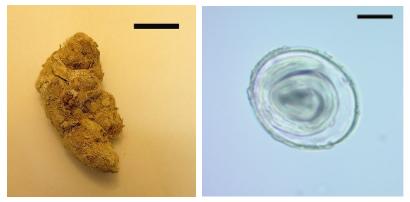16,000-year-old puma poop yields a sample of Ice Age parasites - Ars Technica
16,000-year-old puma poop yields a sample of Ice Age parasites - Ars Technica |
| 16,000-year-old puma poop yields a sample of Ice Age parasites - Ars Technica Posted: 28 Aug 2019 07:55 AM PDT  Enlarge / Despite their size, pumas aren't technically "big cats," a title reserved for the family Pantherinae. By Wolves201 - Own work, CC BY-SA 4.0, https://commons.wikimedia.org/w/index.php?curid=60454559 When you're an 80kg (180lb) apex predator with massive teeth and claws, the world is your litter box—but you might have to wait a few thousand years for someone to come along and clean it up. Archaeologists recently scooped up a dried piece of 16,500-year-old puma feces (called a coprolite) from the floor of the Peñas de las Trampas rock shelter in the mountains of northwest Argentina. The cold, dry environment helped preserve the material, along with its cargo of a few dozen roundworm eggs, well enough for parasitologist Romina Petrigh and her colleagues to sequence DNA from the eggs. The result is the oldest DNA ever recovered from feces and the oldest parasite DNA ever sequenced. Big cats and tiny wormsMitochondrial DNA from the coprolite itself revealed what had left the evidence behind: a puma, the largest member of the family Felidae, which also includes domestic cats. The dried-up calling card showed that Ice Age pumas shared the southernmost reaches of South America with giant ground sloths, now-extinct American horses, and the relatives of modern alpacas and llamas. It also offers a sample of the less-charismatic part of the ecosystem: the parasites that infected the local megafauna. The combination is a snapshot of the complex, untouched world people first walked into around 15,000 years ago (as far as we know based on current evidence; the human settlement timeline is regularly revised as new sites turn up). The 64 tiny roundworm eggs mixed in with the remains of the Pleistocene puma's last meal can tell us something about how parasites and their hosts have co-evolved over the last few thousand years. The roundworm Toxascaris leonina lives most of its life attached to the intestinal lining of carnivores like cats, dogs, and foxes, where it can cause diarrhea, vomiting, and other unpleasant digestive symptoms. Animals pick up the 7-10cm (3-4in.) passengers when they eat an infected rodent—where larvae sometimes lie in wait for a better host—or swallow a bit of egg-laden feces (anyone with a dog and a litterbox in the same house knows that these things happen). Although the new find shows that T. leonina is an ancient pest, the roundworm still infects modern pets and wild carnivores pretty regularly. It's so common in domestic cats and dogs that, until recently, scientists thought domestic carnivores had originally spread the parasite to their wild neighbors in the first place. But if pumas in Argentina had intestines full of T. leonina before humans and their domesticated dogs made it so far south, it can't have been domestic pets' fault. "The common interpretation is that presence of T. leonina in American wild carnivores today is a consequence of their contact with domestic dogs or cats," Petrigh told Ars, "but that should no longer be assumed as the only possible explanation."  The object on the left is a 16,500-year-old puma coprolite. The object on the right is a roundworm egg; T. leonina eggs range from 70 to 99 micrometers in diameter. Romina S. Petrigh, et al Think of them as smelly time capsulesWhen you look at the image above, you probably only see a dried-up chunk of cat poop (sorry, not sorry). Biologists like Petrigh and her colleagues see a reservoir of information about ancient ecology and the long, complex evolutionary history of parasites and their hosts. Archaeologists and biologists have studied parasite eggs from human and animal coprolites, from ancient latrines, in the soil of archaeological graves, and even from mummified peoples' digestive tracts. To better understand the ecosystem of ancient South America—especially which parasites the first human explorers might have encountered—Petrigh and her colleagues are hoping for similar finds from the area. "Our goal is to compare ancient DNA sequences of T. leonina eggs found in other archaeological sites from Argentina," Petrigh told Ars. The team also has more coprolites from the Peñas de las Trampas rock shelter to study, as well—and a few of them may turn out to be from humans. Parasitology, 2019. DOI: 10.1017/S0031182019000787 (About DOIs). |
| Summertime Parasites: Parasites, an all too Common Ingredient in our Foods. - Food Poisoning News Posted: 05 Aug 2019 12:00 AM PDT Summertime Parasites: Parasites in our Foods – an all too Common Ingredient. As we enjoy the fleeting days of summer, gobbling up the bounty of summertime fruits and vegetables, we may be ingesting more than we bargained for. Parasites, microscopic in size and undetectable to the human eye, are often linked to imported produce such as berries, herbs, lettuce and sweet peas. One of the most common of the parasitic intestinal illnesses is Cyclospora. A parasite most commonly found in tropical or subtropical regions, Cyclospora is not spread from human to human but rather from ingesting contaminated foods or water. Although this one-cell parasite is most predominately associated with imported foods – having made their way into our grocery stores and restaurants – as part of salads, sauces or fruity drinks, outbreaks have been linked to locally grown produce as well. It is important, then, to practice food safety handling in all cases. Foodborne illnesses affect people to varying degrees. Individuals who have compromised immune systems, not fully developed or weakened immune systems, such as the very young, or elderly, are most at risk of experiencing dangerous symptoms. Symptoms of Cyclosporiasis can include diarrhea, vomiting, loss of weight and appetite, fever and fatigue, amongst others. Symptoms can surface within forty-eight hours or take nearly two weeks to develop. It is important to seek medical care to ensure the correct course of treatment is administered. Generally, antibiotics are recommended, along with rest and hydration.  Although it is important to wash foods before consumption and, in general practice safe food handling, parasitic infections can be trickier to prevent. Washing of foods contaminated with parasites does not always rid the foods of contamination. Microbes, making their way into our systems can range from viruses to bacteria to organisms of different sizes. Plant and animal foods can carry a multitude of parasites and the symptoms will vary depending on the type. There may exist muscle pain, skin lesions, neurological symptoms in addition to abdominal distress and diarrhea, depending on the specific parasite. As we enjoy the seasonal goodness of fresh, raw produce and indulge in BBQs with seafood, burgers and steaks, it is important to be mindful of food safety. Meats should be cooked to the appropriate temperature, fruits and vegetables washed and prepared separate from meats or other contaminates. And, we should pay attention to public health alerts and warnings about outbreaks and recalls since it is impossible to prevent every foodborne illness, as in the case of parasites. If you suspect you have contracted an illness from a particular food source it is important to alert the provider of the product and your local public health officials. This practice, along with safe food handling, is the best way to enjoy the fruits of the season and while summer is upon us. https://www.cdc.gov/parasites/food.html https://www.cdc.gov/parasites/cyclosporiasis/index.html https://www.mayoclinic.org/diseases-conditions/cyclospora/symptoms-causes/syc-20353068 https://finance.yahoo.com/news/first-mexican-basil-cyclospora-lawsuit-191200980.html |
| You are subscribed to email updates from "What is the most common parasite" - Google News. To stop receiving these emails, you may unsubscribe now. | Email delivery powered by Google |
| Google, 1600 Amphitheatre Parkway, Mountain View, CA 94043, United States | |

Comments
Post a Comment